I think a genetic algorithm might work quite well in this case. Here's a quick example thrown together using deap, based loosely on their example here:
import numpy as np
import deap
from deap import algorithms, base, tools
import imp
class GeneticDetMinimizer(object):
def __init__(self, N=30, popsize=500):
# we want the creator module to be local to this instance, since
# creator.create() directly adds new classes to the module's globals()
# (yuck!)
cr = imp.load_module('cr', *imp.find_module('creator', deap.__path__))
self._cr = cr
self._cr.create("FitnessMin", base.Fitness, weights=(-1.0,))
self._cr.create("Individual", np.ndarray, fitness=self._cr.FitnessMin)
self._tb = base.Toolbox()
# an 'individual' consists of an (N^2,) flat numpy array of 0s and 1s
self.N = N
self.indiv_size = N * N
self._tb.register("attr_bool", np.random.random_integers, 0, 1)
self._tb.register("individual", tools.initRepeat, self._cr.Individual,
self._tb.attr_bool, n=self.indiv_size)
# the 'population' consists of a list of such individuals
self._tb.register("population", tools.initRepeat, list,
self._tb.individual)
self._tb.register("evaluate", self.fitness)
self._tb.register("mate", self.crossover)
self._tb.register("mutate", tools.mutFlipBit, indpb=0.025)
self._tb.register("select", tools.selTournament, tournsize=3)
# create an initial population, and initialize a hall-of-fame to store
# the best individual
self.pop = self._tb.population(n=popsize)
self.hof = tools.HallOfFame(1, similar=np.array_equal)
# print summary statistics for the population on each iteration
self.stats = tools.Statistics(lambda ind: ind.fitness.values)
self.stats.register("avg", np.mean)
self.stats.register("std", np.std)
self.stats.register("min", np.min)
self.stats.register("max", np.max)
def fitness(self, individual):
"""
assigns a fitness value to each individual, based on the determinant
"""
return np.linalg.det(individual.reshape(self.N, self.N)),
def crossover(self, ind1, ind2):
"""
randomly swaps a subset of array values between two individuals
"""
size = self.indiv_size
cx1 = np.random.random_integers(0, size - 2)
cx2 = np.random.random_integers(cx1, size - 1)
ind1[cx1:cx2], ind2[cx1:cx2] = (
ind2[cx1:cx2].copy(), ind1[cx1:cx2].copy())
return ind1, ind2
def run(self, ngen=int(1E6), mutation_rate=0.3, crossover_rate=0.7):
np.random.seed(seed)
pop, log = algorithms.eaSimple(self.pop, self._tb,
cxpb=crossover_rate,
mutpb=mutation_rate,
ngen=ngen,
stats=self.stats,
halloffame=self.hof)
self.log = log
return self.hof[0].reshape(self.N, self.N), log
if __name__ == "__main__":
np.random.seed(0)
gd = GeneticDetMinimizer()
best, log = gd.run()
It takes about 40 seconds to run 1000 generations on my laptop, which gets me from a minimum determinant value of about -5.7845x108 to -6.41504x1011. I haven't really played around much with the meta-parameters (population size, mutation rate, crossover rate etc.), so I'm sure it's possible to do a lot better.
Here's a greatly improved version that implements a much smarter crossover function that swaps blocks of rows or columns across individuals, and uses a cachetools.LRUCache to guarantee that each mutation step produces a novel configuration, and to skip evaluation of the determinant for configurations that have already been tried:
import numpy as np
import deap
from deap import algorithms, base, tools
import imp
from cachetools import LRUCache
# used to control the size of the cache so that it doesn't exceed system memory
MAX_MEM_BYTES = 11E9
class GeneticDetMinimizer(object):
def __init__(self, N=30, popsize=500, cachesize=None, seed=0):
# an 'individual' consists of an (N^2,) flat numpy array of 0s and 1s
self.N = N
self.indiv_size = N * N
if cachesize is None:
cachesize = int(np.ceil(8 * MAX_MEM_BYTES / self.indiv_size))
self._gen = np.random.RandomState(seed)
# we want the creator module to be local to this instance, since
# creator.create() directly adds new classes to the module's globals()
# (yuck!)
cr = imp.load_module('cr', *imp.find_module('creator', deap.__path__))
self._cr = cr
self._cr.create("FitnessMin", base.Fitness, weights=(-1.0,))
self._cr.create("Individual", np.ndarray, fitness=self._cr.FitnessMin)
self._tb = base.Toolbox()
self._tb.register("attr_bool", self.random_bool)
self._tb.register("individual", tools.initRepeat, self._cr.Individual,
self._tb.attr_bool, n=self.indiv_size)
# the 'population' consists of a list of such individuals
self._tb.register("population", tools.initRepeat, list,
self._tb.individual)
self._tb.register("evaluate", self.fitness)
self._tb.register("mate", self.crossover)
self._tb.register("mutate", self.mutate, rate=0.002)
self._tb.register("select", tools.selTournament, tournsize=3)
# create an initial population, and initialize a hall-of-fame to store
# the best individual
self.pop = self._tb.population(n=popsize)
self.hof = tools.HallOfFame(1, similar=np.array_equal)
# print summary statistics for the population on each iteration
self.stats = tools.Statistics(lambda ind: ind.fitness.values)
self.stats.register("avg", np.mean)
self.stats.register("std", np.std)
self.stats.register("min", np.min)
self.stats.register("max", np.max)
# keep track of configurations that have already been visited
self.tabu = LRUCache(cachesize)
def random_bool(self, *args):
return self._gen.rand(*args) < 0.5
def mutate(self, ind, rate=1E-3):
"""
mutate an individual by bit-flipping one or more randomly chosen
elements
"""
# ensure that each mutation always introduces a novel configuration
while np.packbits(ind.astype(np.uint8)).tostring() in self.tabu:
n_flip = self._gen.binomial(self.indiv_size, rate)
if not n_flip:
continue
idx = self._gen.random_integers(0, self.indiv_size - 1, n_flip)
ind[idx] = ~ind[idx]
return ind,
def fitness(self, individual):
"""
assigns a fitness value to each individual, based on the determinant
"""
h = np.packbits(individual.astype(np.uint8)).tostring()
# look up the fitness for this configuration if it has already been
# encountered
if h not in self.tabu:
fitness = np.linalg.det(individual.reshape(self.N, self.N))
self.tabu.update({h: fitness})
else:
fitness = self.tabu[h]
return fitness,
def crossover(self, ind1, ind2):
"""
randomly swaps a block of rows or columns between two individuals
"""
cx1 = self._gen.random_integers(0, self.N - 2)
cx2 = self._gen.random_integers(cx1, self.N - 1)
ind1.shape = ind2.shape = self.N, self.N
if self._gen.rand() < 0.5:
# row swap
ind1[cx1:cx2, :], ind2[cx1:cx2, :] = (
ind2[cx1:cx2, :].copy(), ind1[cx1:cx2, :].copy())
else:
# column swap
ind1[:, cx1:cx2], ind2[:, cx1:cx2] = (
ind2[:, cx1:cx2].copy(), ind1[:, cx1:cx2].copy())
ind1.shape = ind2.shape = self.indiv_size,
return ind1, ind2
def run(self, ngen=int(1E6), mutation_rate=0.3, crossover_rate=0.7):
pop, log = algorithms.eaSimple(self.pop, self._tb,
cxpb=crossover_rate,
mutpb=mutation_rate,
ngen=ngen,
stats=self.stats,
halloffame=self.hof)
self.log = log
return self.hof[0].reshape(self.N, self.N), log
if __name__ == "__main__":
np.random.seed(0)
gd = GeneticDetMinimizer(0)
best, log = gd.run()
My best score thus far is about -3.23718x1013 -3.92366x1013 after 10000 1000 generations, which takes about 45 seconds on my machine.
Based on the solution cthonicdaemon linked to in the comments, the maximum determinant for a 31x31 Hadamard matrix must be at least 75960984159088×230 ~= 8.1562x1022 (it's not yet proven whether that solution is optimal). The maximum determinant for an (n-1 x n-1) binary matrix is 21-n times the value for an (n x n) Hadamard matrix, i.e. 8.1562x1022 x 2-30 ~= 7.5961x1013, so the genetic algorithm gets within an order of magnitude of the current best known solution.
However, the fitness function seems to plateau around here, and I'm having a hard time breaking -4x1013. Since it's a heuristic search there is no guarantee that it will eventually find the global optimum.

